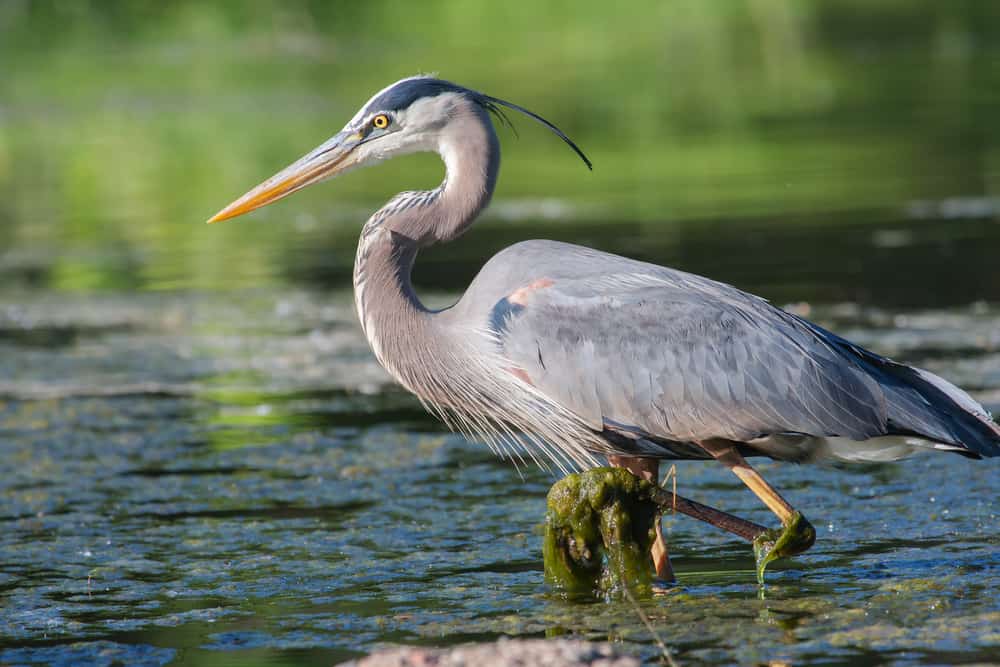Herons are large hunting birds that play a huge role in their ecosystem. They are responsible for maintaining the balance of their habitat composition. Their role is to be a predator of other small species in the coastal area, and they have great instincts and sharp reflexes. They are known for hunting small mammals and fish fauna.
Herons can swim and fly, which makes them strong predators. If you’re interested in knowing more about herons’ diet and behavior, read on. In this comprehensive guide, we’ll teach you everything you should know about these birds.
Herons Facts
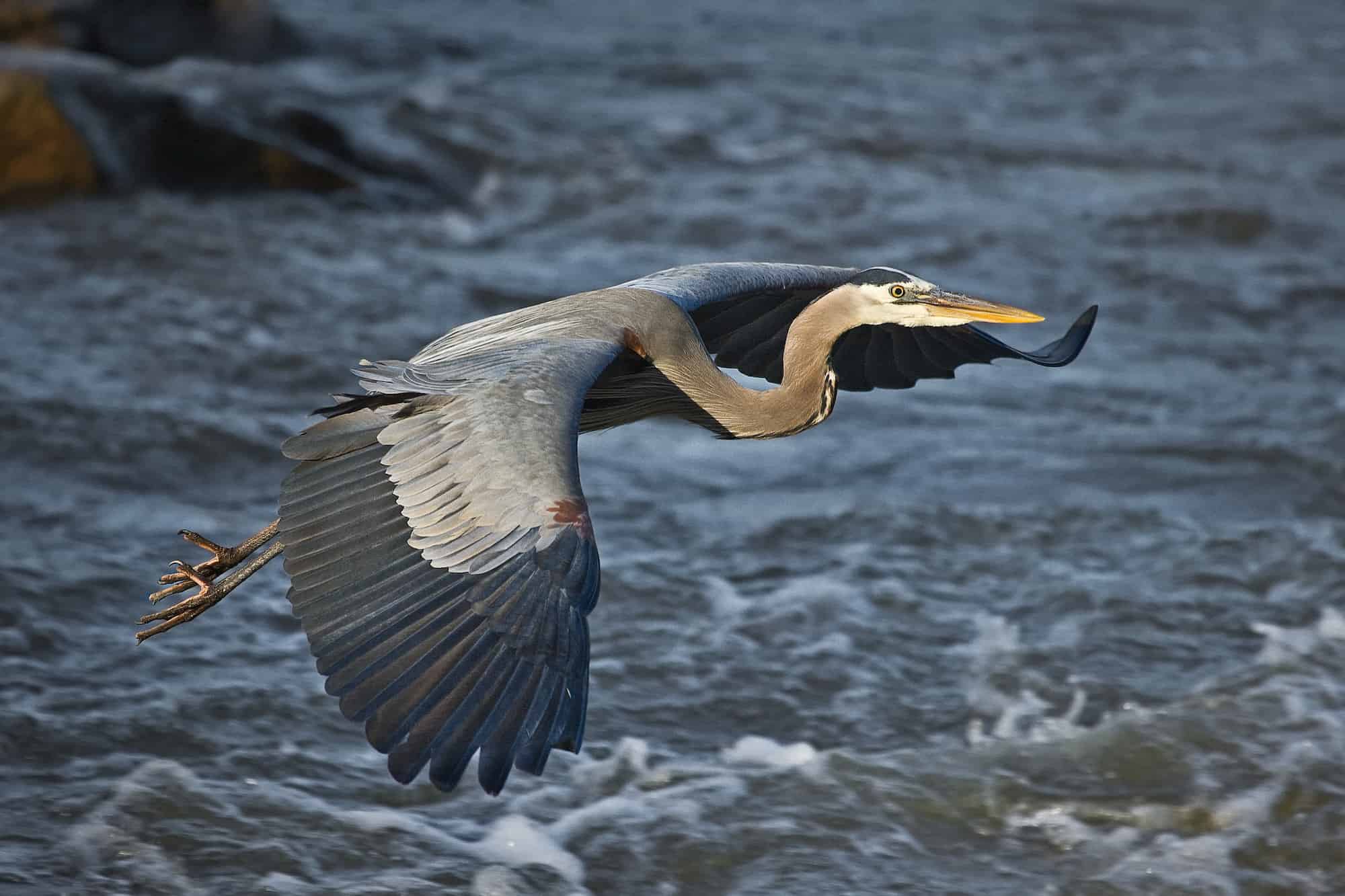
Herons are carnivorous birds that can swim and live near coastal areas. There are around 63 types of herons, including the most common one called the Great Blue Heron, which can be found the most on North America’s coasts.
The average size of the blue heron is 3.2 to 4.5 feet, but there are larger species, such as the goliath heron, which can be as tall as 5ft. The smallest heron type is the dwarf bittern which can go from ten to 12 inches. Considering herons are large birds, you may think they’re heavy, but their average weight goes from five to six pounds.
Characteristics
Herons are large species with a huge wingspan that usually doubles the size of their bodies. The average heron wingspan size can go from 5.5 ft to 6ft. They also have a large peak that they use for hunting. Most herons are blue, but they can also be white and grey. They have fine feathers and develop plumes during their mating season.
Depending on the species, they also have long, thin, yellow, or black legs. Herons generally have a long neck that is S-shaped to support their heavy beak. They are also considered wading birds.
Distribution And Habitat
Herons live on almost every continent but prefer tropical and wetland areas. That’s why you won’t find them in Antarctica and other regions with extreme weather conditions like the desert. They also prefer lowland areas, so you won’t see them in extremely high mountains.
Considering they are water-associated creatures, they usually live near the coast, in swamps, lakes, mud flats, wetlands, and marshes. If you have a pond in your house, you might also get some herons to visit you once in a while. However, this might be inconvenient if you have pond fish. Herons are generally migratory species, except for the grey herons in Britain, due to their appropriate weather conditions.
What Do Herons Eat?
Herons eat a large variety of other smaller animals like mammals, insects, and fish. However, you should keep in mind that there’s a wide variety of heron species that come from the same family. Therefore, their diet may be different depending on their species. Some of them have adapted their eating habits based on what’s available in their environment.
Some heron species have specialized in a particular group, such as insects, amphibians, rodents, reptiles, and crustaceans. For instance, the yellow-crowned night heron only eats crustaceans and mostly crabs.
The cattle egret is smaller, so it mostly eats insects. However, normal-sized herons will eat pretty much any animal they can swallow. Below we have compiled a list of some of the most common heron foods. Considering there are so many species, we’ll focus on a broad spectrum of prey.
What do Baby Herons Eat?
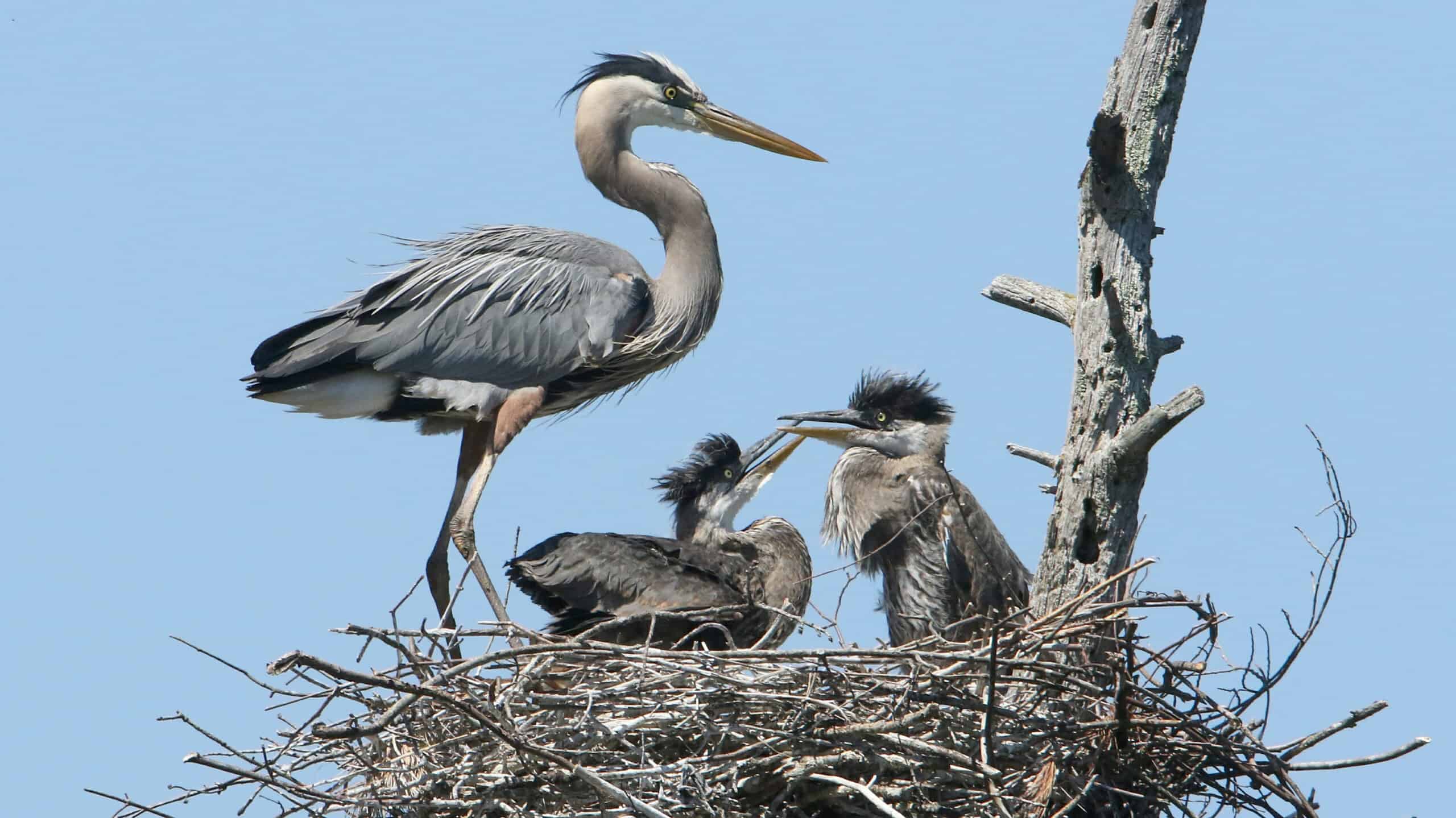
Young herons are usually fed by their parents in the nests with insects, fish, amphibians, and crustaceans. Considering their size, they must only eat small animals that they can easily digest without getting stuck.
You probably won’t see a baby heron too often because their parents usually keep them hidden in their nest for up to 90 days after hatching. Their nests are placed 100 ft off the ground. Baby herons also eat regurgitated food to help them with digestion. They will start eating animals directly from their parents’ mouths when they’re around 30 days after hatching.
How Do Herons Find And Hunt Their Prey?
They will stalk their prey silently and patiently until the right moment comes. Once they’ve decided to hunt them, they will proceed to use their peak to impale their prey. This process is called ‘bill stab’. Then, they will shake the animal to break their bones and spine so they can easily swallow them. All of this while the animal is still alive.
Even though they may seem harmless, herons have a deeply savage and hostile hunting process. They can even gulp down prey that is double the size of their elongated neck. They are also known for eating other small birds while they’re flying.
What Is The Heron’s Diet In Captivity?
Herons in captivity eat anything that’s available to them. This could be fish, amphibians, or insects. If you caught them near a body of water such as a pond, it could mean they’re looking for their next meal.
Should You Feed Herons with Bread?
No, you shouldn’t feed herons with bread. Although this is a common practice, especially on the coast, it won’t give any necessary nutrients to herons. They’re carnivorous, so they should be fed with flesh or small animals. According to the University of Florida, IFAS extension, if you constantly feed a heron with bread, it will cause malnutrition and eventually lead to death.
What Eats Them And How Do They Avoid Being Eaten?
Some of the most common heron predators are bears because they’re bigger, carnivorous, and can live near their habitat. It is extremely hard for other small animals to hunt adult-sized herons. However, other species like raccoons, crows, vultures, hawks, eagles, and ravens can hunt juvenile herons and eggs.
Yet, one of the greatest heron predators is humans. This is because humans cause disturbances in nesting colonies and degrade their habitat. This reduces their availability of food. Some humans also hunt them for entertainment.
Issues you can have with Herons?
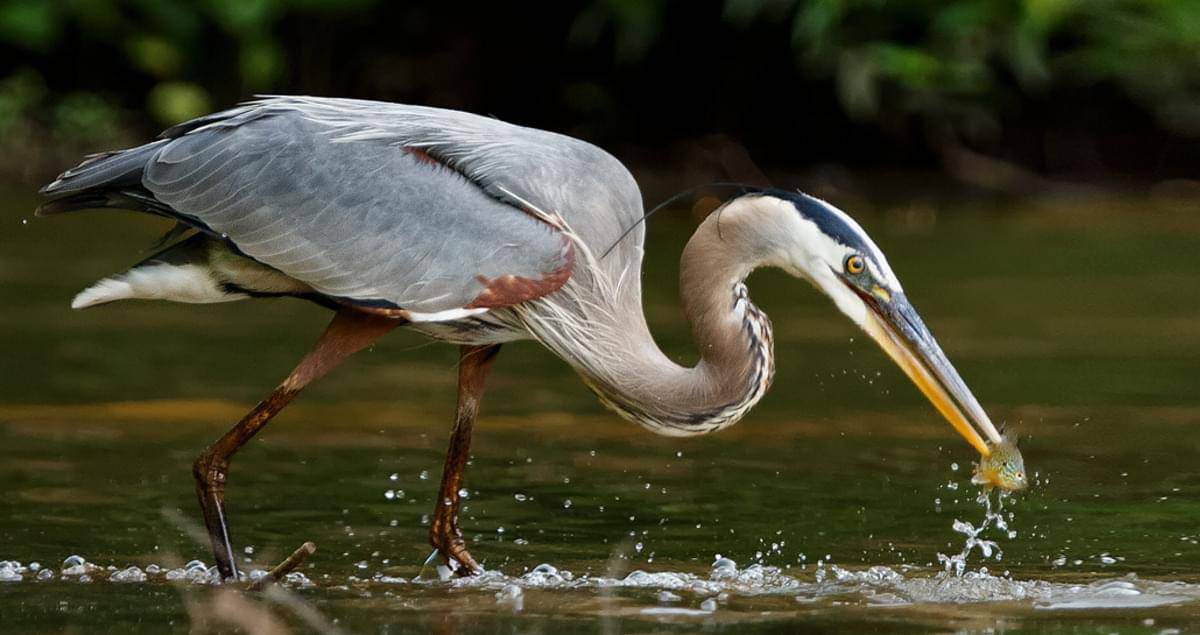
Herons are usually harmless but can cause problems in your house if you have a pond. If you have one, the heron can perceive it as a water and food source, especially if you have fish in your pond. This will make it more attractive for them, and they’ll visit you more frequently.
If you want to deter herons from hunting fish in your pond, there are a couple of things you can do. The first alternative is to cover it with a net. Although it can be visually unappealing, it is quite effective. If you don’t like the idea of hiding it, you can only do it at night or try other methods.
Other efficient ways to deter them is by installing motion-activated sprinklers, lighting, and sound systems. This will spook the herons and drive them away from your property. Other people try pond poisoning, but it doesn’t work if you have fish.
Always make sure to add hiding places for fish. This way, they can protect themselves from this predator. You can also include some shrubs near the pond to scare herons and prevent them from landing on it.
Herons Misconceptions
Herons are instinctive animals known for their excellent hunting skills. However, there are some misconceptions we’ve always had about them, and it’s time to demystify them. Below, you’ll find some of the most common heron myths:
- Herons only eat fish. Herons have a diverse diet, including all types of small mammals and fish fauna. Their diet is definitely not limited to fish only.
- Herons are the same species as cranes. That’s incorrect. Although they have some similarities, they are different species. Herons come from the family of Ardeidae, whereas cranes are in the group of Gruiformes.
- Herons are monogamous. This misconception is totally understandable because it’s not so far from reality. Herons mate with a particular female and remain with them for a year. However, they’ll look for another mate during the next breeding season, so they are indeed polygamous.
Fun Facts About Herons
- Herons stalk their prey before hunting them. Herons are known for being patient, agile, and fast. They will stalk their prey for hours before deciding to hunt them instead of spending time chasing them.
- They’re called dinosaur birds. The most ancient record of herons is from 1.8 million years ago, but some animal experts claim they lived on earth 25 million years ago. This belief has grown due to their characteristic sound when flapping.
- They have autocleaning feathers. Their feathers are constantly growing, so old ones will turn into a special powder to clean them and remove fish slime.
- Both parents are participants in the breeding process. When breeding their chicks, both parents participate in creating the nest and feeding them.
- Their colors demonstrate interesting facts such as their mating season, age, and gender. Male herons have brighter orange legs than females. Their peak also changes when they’re in their mating season. Their eyes will also turn reddish.
Are Stork, Herons, and Egrets the Same Species?
There’s common confusion about these three types of birds because of their similarities. They’re all wading birds with long necks and legs. You should know that egrets and herons are the same species because they belong to the same family, which is Ardeidae. On the other hand, Storks come from the Ciconiidae family, making them a completely different specimen.
Yet they all share similarities in shape and behavior. These three species are often found near rivers and coasts. Their diet is also similar as they eat small mammals and fish. They all have large peaks to hunt their prey.
Can Herons Hurt Humans?
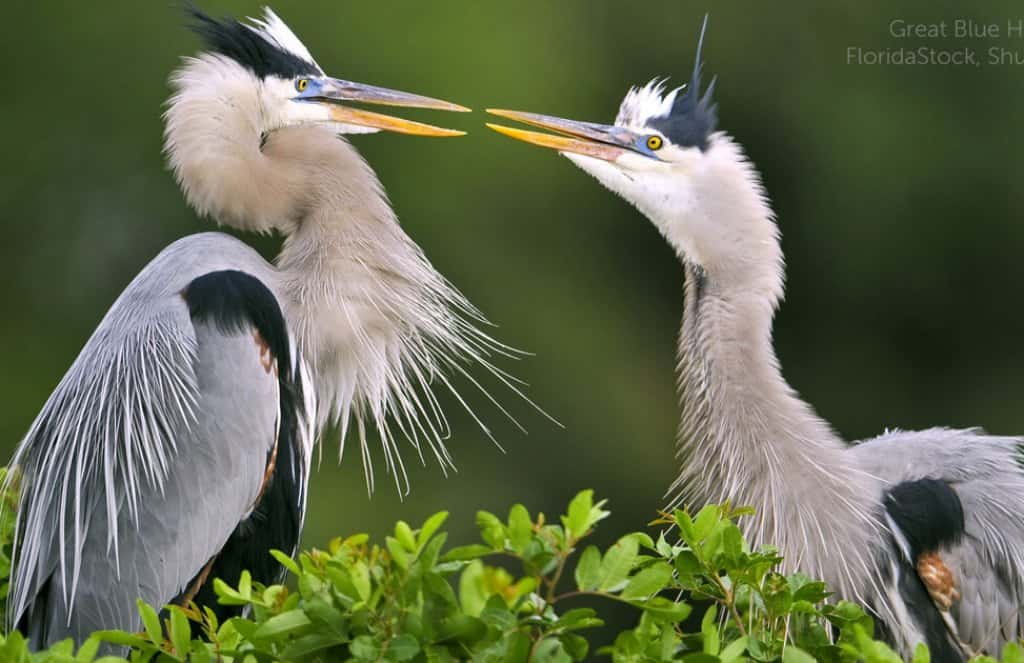
Herons are generally not harmful to humans, but they can definitely attack you if they are scared. They have a strong beak that can certainly harm you and even kill you, depending on where it strikes. That’s why it’s so important to give them space. Remember that they are wild animals and, therefore, almost unpredictable.
Conservation
Are Herons in Danger of Extingtion?
Herons are often affected by human intervention in their habitats and hunting practices. However, there’s still a large population of herons worldwide. Yet, remember that there’s a wide list of heron species, and not all of them are in the same conditions. The white-bellied heron is in critical danger of extinction.
The reason for its potential extinction is because of human distortion and degradation of lowlands in forests and wetlands near their habitat. Their population size goes from 50 to 249 worldwide, and it’s expected to decrease in the upcoming years.
Are Herons Protected?
Yes, according to the U.S. Department of Agriculture Animal & Plant Health Inspection Service, herons are protected by the Migratory Bird Treaty Act. That’s why their habitat cannot be manipulated by human intervention, especially during the breeding season. Hunting herons are also prohibited.
The Migratory Bird Treaty Act prohibits capturing, killing, hunting, transporting, and selling migratory birds unless you have been authorized by the Department of Interior U.S. Fish and Wildlife Service. Other countries that are part of this treaty include Canada, Mexico, and Russia.
The list of protected birds is extensive, including falcons, perching birds, and woodpeckers. The penalty for committing a crime against herons or any other protected bird is either 15 days of jail or $250.
Conclusion
Herons are wild animals with strong instincts and reflexes. These animals are known for their imponent wingspan and large peak. They have an impressive hunting process and a large variety of species in their diet. Herons eat amphibians, crustaceans, small birds, rodents, and fish.
If you’ve ever encountered one of them, you’ll know that they are generally harmless, but they can certainly attack fish in domestic ponds and become an issue for homeowners. However, you can implement different strategies to deter them, such as motion-activated sprinklers and hiding places for fish. What do you think about herons now? Did you have any of the common misconceptions we mentioned above?
